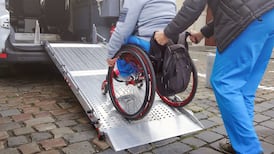The way Covid-19 vaccines have been distributed to healthcare workers raises issues of geographical equity, and fairness of access for people who do not work in large centres, according to new guidelines.
The Health Service Executive has published guidance on the sequencing of vaccines for frontline healthcare workers - over a month after they were identified as the second priority group behind people in nursing homes and after almost 80,000 have been inoculated.
The guidance was issued last Tuesday, five days after the Coombe hospital administered doses to 16 family members of staff.
The sequencing of vaccine administration has to be considered in the context of available volumes of vaccine and the practicalities of administration, according its author, HSE chief clinical officer Dr Colm Henry.
“This is inevitably disappointing and frustrating for those who see colleagues have the benefit of vaccine while they have to wait,” he says, adding that the purpose of his paper is to outline an approach based on “reasonable and fair” principles.
The Pfizer/BioNTech vaccine given to most healthcare workers has to be transported at ultra-cold temperatures and can be stored in a fridge for up to five days before use. Once diluted in a suspension, it has to be used within six hours.
Dr Henry says healthcare worker is a broad category that includes people at very different levels of increased risk.
The sequencing process needs to be practical and transparent and based on the best practical estimate of exposure risk, he says. It should not be based on where people work (in the community or a hospital), who they work for (public or private), or the category or grade of worker.
Doses should be administered “as promptly as possible” and “no dose should be wasted”, he says.
Among frontline workers, Dr Henry proposes a sequence of eight sub-groups in order of priority, starting with “healthcare workers who are working in a congregated care setting where there is current active transmission of Covid-19”.
Next come workers dealing with unscheduled care of patients on a daily basis “in an uncontrolled environment”, such as paramedics.
GPs and practice nurses, “who occasionally deal with unscheduled care patients”, rank fifth in this sequencing.
After frontline workers, Dr Henry proposes two further groups for sequencing: Healthcare workers whose work does not involve direct contact with people but does involve contact with potentially infectious blood or body fluids or human remains in a controlled environment; and “other healthcare workers not in direct patient contact”.
“Although it would be ideal that the order in which healthcare workers have access to vaccination should be based entirely on the sequencing outlined below this may not always be achievable because administration has to be organised in a practical way.
“Every effort should be made to ensure that vaccine should be made available to frontline healthcare workers in order of sequencing rather than given primarily to people later in the sequence who work in the institution that hosts the vaccination centre,” he says.
To ensure supplies are used, centres should proceed down the sequence order if highest priority frontline workers are not available, the paper says. Centres should establish standby lists of lower sequence frontline staff, and then other health staff, that are available at short notice, who should be randomly selected if frontline workers are not available.











